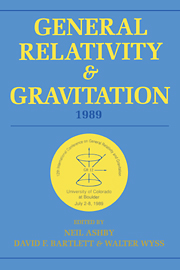 General Relativity and Gravitation, 1989
General Relativity and Gravitation, 1989 Book contents
- Frontmatter
- Contents
- Preface
- Conference committees
- Part A Classical relativity and gravitation theory
- WORKSHOPS
- Part B Relativistic astrophysics, early universe, and classical cosmology
- WORKSHOPS
- Part C Experimental gravitation and gravitational wave detection
- WORKSHOPS
- Part D Quantum gravity, superstrings, quantum cosmology
- WORKSHOPS
- D1 Theories of quantum gravity I (superstring theory)
- D2 New Hamiltonian variables
- D3 Quantum cosmology and baby universes
- D4 Quantum field theory in curved spacetime
- D5 Theories of quantum gravity II (not superstring theory)
- Part E Overviews-past, present, and future
D3 - Quantum cosmology and baby universes
Published online by Cambridge University Press: 05 March 2012
- Frontmatter
- Contents
- Preface
- Conference committees
- Part A Classical relativity and gravitation theory
- WORKSHOPS
- Part B Relativistic astrophysics, early universe, and classical cosmology
- WORKSHOPS
- Part C Experimental gravitation and gravitational wave detection
- WORKSHOPS
- Part D Quantum gravity, superstrings, quantum cosmology
- WORKSHOPS
- D1 Theories of quantum gravity I (superstring theory)
- D2 New Hamiltonian variables
- D3 Quantum cosmology and baby universes
- D4 Quantum field theory in curved spacetime
- D5 Theories of quantum gravity II (not superstring theory)
- Part E Overviews-past, present, and future
Summary
The contributed papers presented to the GR-12 workshop on “Quantum Cosmology and Baby Universes” have demonstrated the great interest in, and rapid development of, the field of quantum cosmology. In my view, there are at least three areas of active research at present. The first area can be defined as that of practical calculations. Here researchers are dealing with the basic quantum cosmological equation, which is the Wheeler-DeWitt equation. They try to classify all possible solutions to the Wheeler-DeWitt equation or seek a specific integration contour in order to select one particular wave function of generalize the simple minisuperspace models to more complicted cases, including various inhomogeneities, anisotropies, etc. The second area of research deals with the interpretational issues of quantum cosmology. There are still many questions about how to extract the observational consequences from a given cosmological wave function, the role of time in quantum cosmology, and how to reformulate the rules of quantum mechanics in such a way that they could be applicable to the single system which is our Universe. The third area of research is concerned with the so-called “third quantization” of gravity. In this approach a wave function satisfying the Wheeler-DeWitt equation becomes an operator acting on a Wave Function of the many-universes system. Within this approach one operates with Euclidean worm-holes joining different Lorentzian universes. This is, perhaps, one of the most fascinating, although not entirely clear, subjects considered recently.
- Type
- Chapter
- Information
- General Relativity and Gravitation, 1989Proceedings of the 12th International Conference on General Relativity and Gravitation, pp. 463 - 466Publisher: Cambridge University PressPrint publication year: 1990
